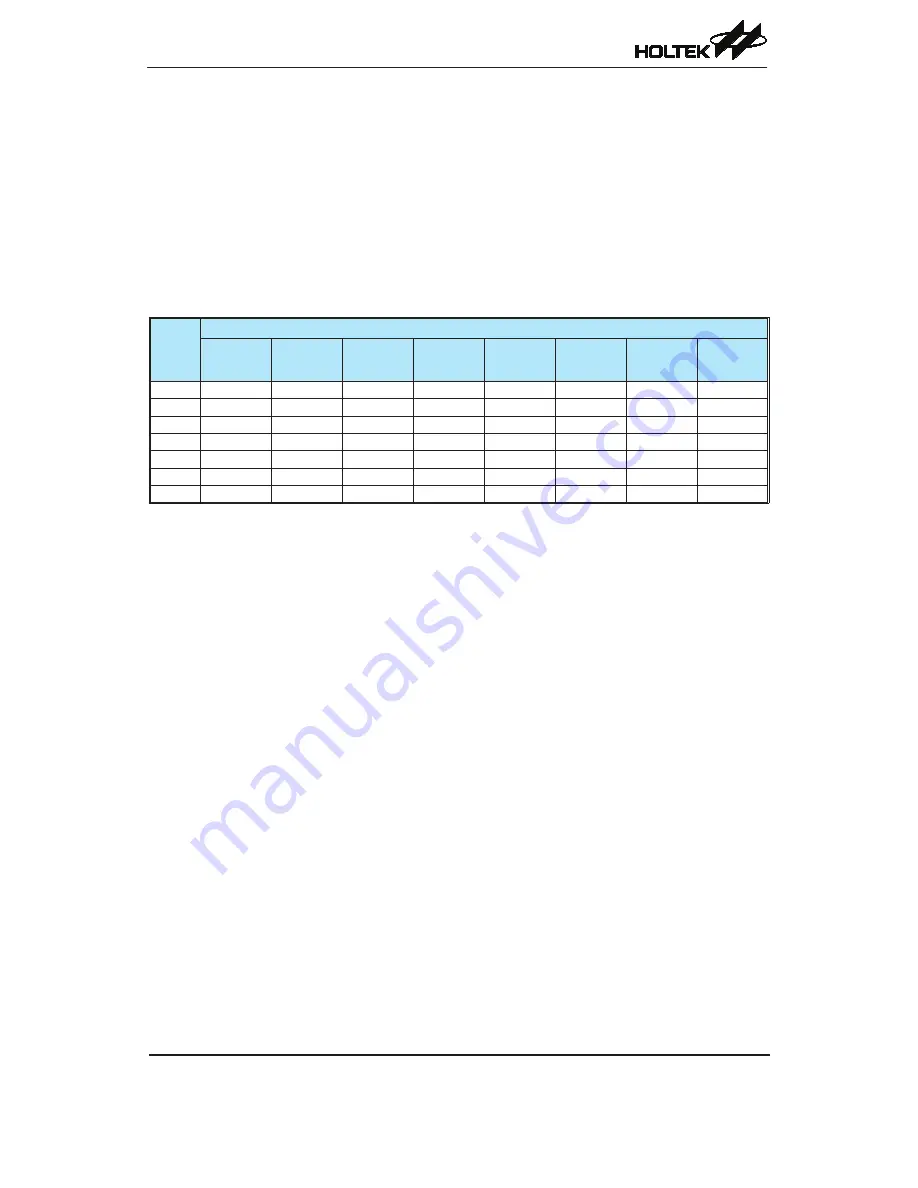
Rev. 1.50
1�4
����st ��� �01�
Rev. 1.50
1�5
����st ��� �01�
HT66F0175/HT66F0185
A/D Flash MCU with EEPROM
HT66F0175/HT66F0185
A/D Flash MCU with EEPROM
The clock source for the A/D converter, which originates from the system clock f
SYS
, can be chosen
to be either f
SYS
or a subdivided version of f
SYS
. The division ratio value is determined by the
SACKS2~SACKS0 bits in the SADC1 register. Although the A/D clock source is determined by the
system clock f
SYS
and by bits SACKS2~SACKS0, there are some limitations on the maximum A/D
clock source speed that can be selected. As the recommended range of permissible A/D clock period,
t
ADCK
, is from 0.5μs to 10μs, care must be taken for system clock frequencies. For example, as the
system clock operates at a frequency of 8MHz, the SACKS2~SACKS0 bits should not be set to 000,
001 or 111. Doing so will give A/D clock periods that are less than the minimum A/D clock period
which may result in inaccurate A/D conversion values. Refer to the following table for examples,
where values marked with an asterisk * show where, depending upon the devices, special care must
be taken, as the values may be less than the specified minimum A/D Clock Period.
f
SYS
A/D Clock Period (t
ADCK
)
SACKS[2:0]
= 000
(f
SYS
)
SACKS[2:0]
= 001
(f
SYS
/2)
SACKS[2:0]
= 010
(f
SYS
/4)
SACKS[2:0]
= 011
(f
SYS
/8)
SACKS[2:0]
= 100
(f
SYS
/16)
SACKS[2:0]
= 101
(f
SYS
/32)
SACKS[2:0]
= 110
(f
SYS
/64)
SACKS[2:0]
= 111
(f
SYS
/128)
1 MHz
1μs
2μs
4μs
8μs
16μs *
32μs *
64μs *
128μs *
� MHz
500ns
1μs
2μs
4μs
8μs
16μs *
32μs *
64μs *
4 MHz
250ns *
500ns
1μs
2μs
4μs
8μs
16μs *
32μs *
� MHz
125ns *
250ns *
500ns
1μs
2μs
4μs
8μs
16μs *
1� MHz
83ns *
167ns *
333ns *
66�ns
1.33μs
2.67μs
5.33μs
10.67μs *
16 MHz
62.5ns *
125ns *
250ns *
500ns
1μs
2μs
4μs
8μs
�0 MHz
50ns *
100ns *
200ns *
400ns *
�00ns
1.6μs
3.2μs
6.4μs
A/D Clock Period Examples
Controlling the power on/off function of the A/D converter circuitry is implemented using the
ADCEN bit in the SADC0 register. This bit must be set high to power on the A/D converter. When
the ADCEN bit is set high to power on the A/D converter internal circuitry, a certain delay, as
indicated in the timing diagram, must be allowed before an A/D conversion is initiated. Even if
no pins are selected for use as A/D inputs, if the ADCEN bit is high, then some power will still be
consumed. In power conscious applications it is therefore recommended that the ADCEN is set low
to reduce power consumption when the A/D converter function is not being used.
Conversion Rate and Timing Diagram
A complete A/D conversion contains two parts, data sampling and data conversion. The data
sampling which is defined as t
ADS
takes 4 A/D clock cycles and the data conversion takes 12 A/D
clock cycles. Therefore a total of 16 A/D clock cycles for an A/D conversion which is defined as t
ADC
are necessary.
Maximum single A/D conversion rate = A/D clock period / 16 (1)
The accompanying diagram shows graphically the various stages involved in an analog to digital
conversion process and its associated timing. After an A/D conversion process has been initiated
by the application program, the microcontroller internal hardware will begin to carry out the
conversion, during which time the program can continue with other functions. The time taken for the
A/D conversion is 16 t
ADCK
clock cycles where t
ADCK
is equal to the A/D clock period.
















































